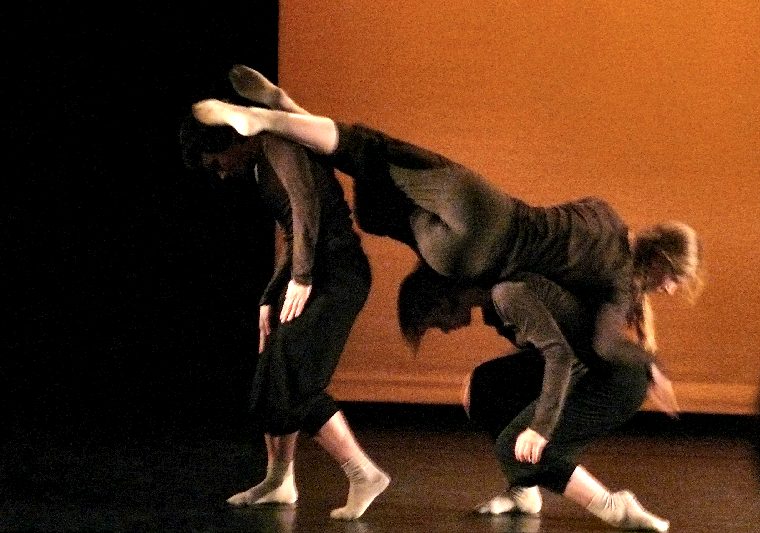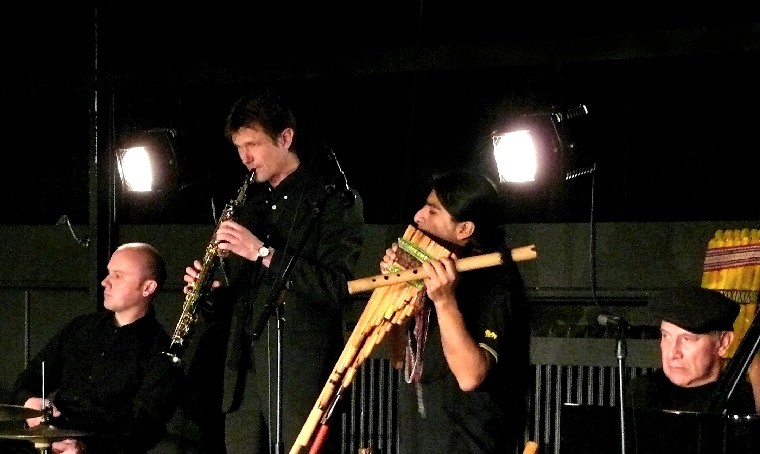Cynthia Gonzalez: Bolivianische Bilder (Bolivian Images)
TANZherbst Dresden, November 2007
Choreography and direction: Cynthia Gonzalez
Dance: Cynthia Gonzalez, Teresa Hackel, Doreen Heidrich, Maggie Nicolai, Irene Schröder
Musicians: Johnny Gonzales, Andre Schubert, Dittmar Trebeljahr, Javier Rosales Alcaron
Bolivian Images presented at Tanzherbst 2007 is a major work of the Bolivian/Dresden choreographer and apart from "Break-Thru" her most substantial piece I have seen. This collage of dance, dance theatre, screen projection and live music was also her first large whole-evening performance presented in Dresden. Cynthia's choreography is concise and to the point, she utilizes just the amount of movement needed to realize an idea and that’s it. No buffers, repetitions or interludes. Even variations on the theme, which have been a vital means through all styles up to modern, are rarely encountered in Cynthia's work. This makes her pieces intense but puts a limit on their length. Whether solos, duos or group choreographies, most of Cynthia's works I saw lasted between 20 and 40 minutes. This is perfect for festivals and shared performances, but the audience of larger stages typically expects a full evening's show and is disappointed if it does not get it, the quality of the choreography notwithstanding. To appeal to this audience, a choreographer has to come up with an eighty minutes plus performance. This requires to alternate tempi, embrace repetitions and variations, make use of intermezzos, and above all reduce the intensity as neither the performers nor the audience can keep up full concentration for that long. In "Bolivian Images" Cynthia Gonzalez as the artistic director and choreograph achieved this by blending dance with visual media and music. She structured the piece into three independent parts, which share a common theme of the hardship, the legends and the beauty of life in rural Bolivia.
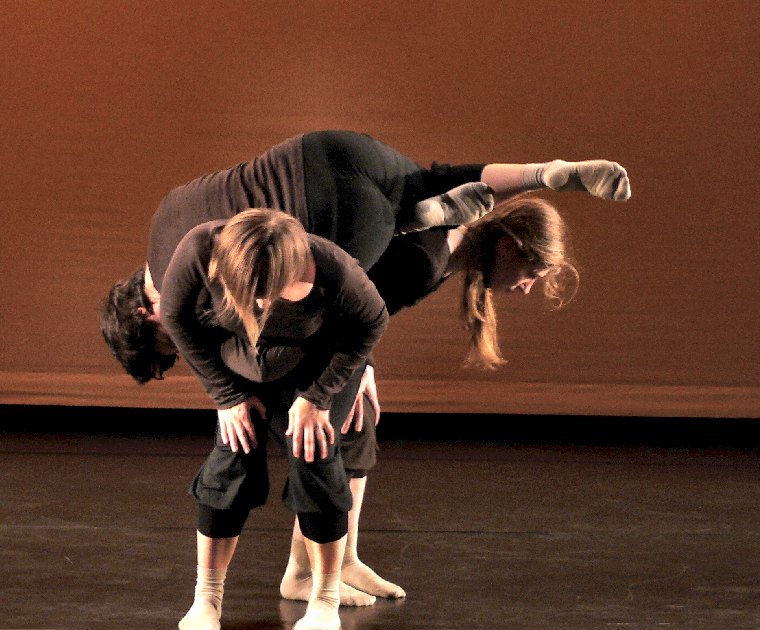
Download larger version (200 kb)
The first part, "Terra mia", connects images of poetical mountains of highland Bolivia in paintings by William Vega with body landscapes constructed by three dancers. Imaginative, bizarre and dangerously looking body sculptures have been Cynthia's specialty, with the highlight I have seen so far being the opening scene in the piece "Break-Thru" (see report), in which she assembled a worm with a big head and antennas.
On the photo above you see Doreen Heidrich (left) and Teresa Hackel (right) carrying Irene Schröder on their backs, who is holding herself in place by embracing Doreen's waist with her left arm. The aesthetical appeal comes from a contrast between the small footprint of the construct and its wide and spacious top, like a tree with a slim trunk holding a large crown. It would come out even better if Doreen Heidrich held her feet close to each other.
The shot above was a real challenge: the scene was so dim that I had to set the sensitivity to 800 ASA (that's why the photo is grainy), wait for a still moment to risk an exposure of 1/8 seconds (without a tripod, that's why the photo is a bit fuzzy) and it still needed a fair amount of digital enhancement. This time Teresa is on top and the construct looks even shakier than the previous one. Doreen and Irene don't use their hands to support Teresa, it is just the balance and coordination among the dancers that keeps Teresa's body in place. Look at Teresa's feet on Irene's shoulders: are they not going to slip in the next second, letting her crash to the ground ungracefully? I assure you that she did not crash, she slid and touched the ground smoothly after her supporter kneeled lower.
Andre Schubert, Dittmar Trebeljahr, Javier Rosales Alcaron and Johnny Gonzales
Here are the musicians. Javier Rosales Alcaron played several Andean flutes (you see two of them) and their sound blended well with the other instruments, which the musicians sometimes used in non-traditional ways. This was particularly the case with Johnny, who likes to reach into the piano to pull and strike the strings with his fingers. Occasionally he also uses wooden parts of the instrument as percussions. The most memorable sound to me was a series of enchanting triads that the musicians generated by combining a tone played by a single piano key with a second tone from a wooden flute and a third tone from the clarinet. It was the right decision to resist the temptation - in case they had such a temptation - to play Latin American folk tunes. Instead the musicians relied mostly on their own compositions with a modern, fresh sound and enough space for improvisation.
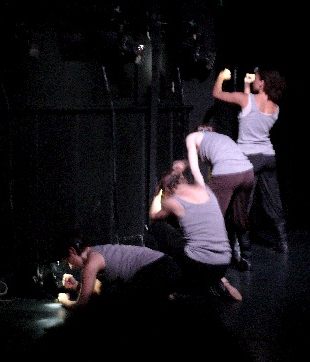
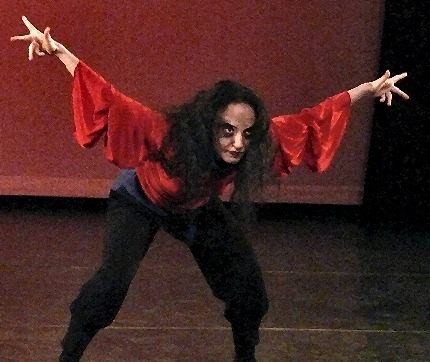
The second part, "Tio de la Mina", began with a performance about the work of miners, reflecting on the deplorable, health-endangering conditions in Bolivian mines. The scene was very short, preparing the stage for the highlight of the evening, which was Cynthia's solo El Tio. On a stage illuminated all in red and wearing the heavy make-up of a witch, Cynthia embodied a powerful creature "El Tio", a mythological ghost who controls the fate of the mine. In her expressive recital she kept her center of gravity low by kneeling and bowing and moved around like a predator, with her fingers stretched apart like claws. Her El Tio was powerful and dominant, possibly evil, but confident and self-satisfied rather than mad.
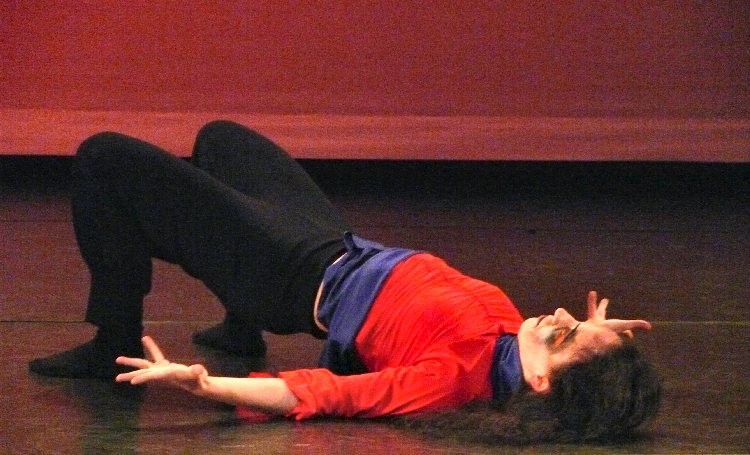

An apt musical background was provided by a vigorous percussion solo of Andre Schubert, who perfectly matched the intensity of Cynthia's dance. The ferocious image was interrupted only once by a short scene in which Cynthia rocked on her back, arms and legs stretched into the air like a baby. The posture, often used in Butoh, was a bit of a puzzle for the audience and perhaps a means to make the intensity stand out by contrast after the dancer slipped back into the skin of El Tio. As I write this I realize that Cynthia's solo recalled Butoh in more than one way: by her flamboyant appearance, the animalistic movement and by excessive floor work with fingers stretched apart.
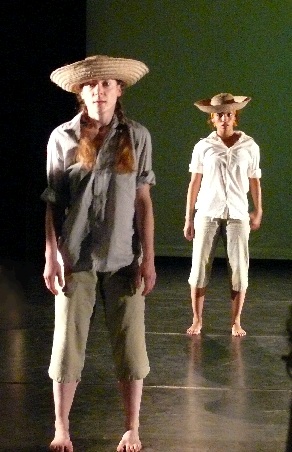
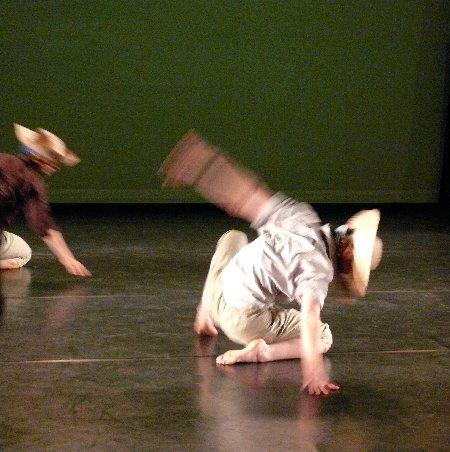
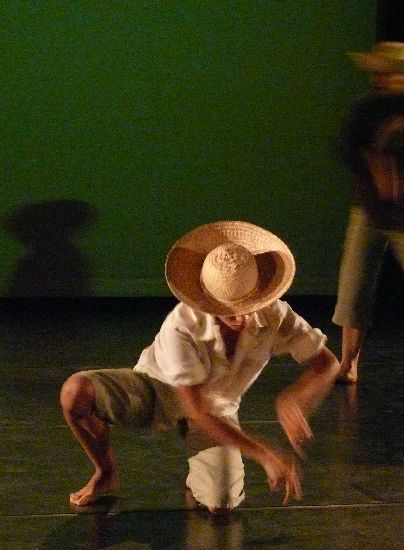
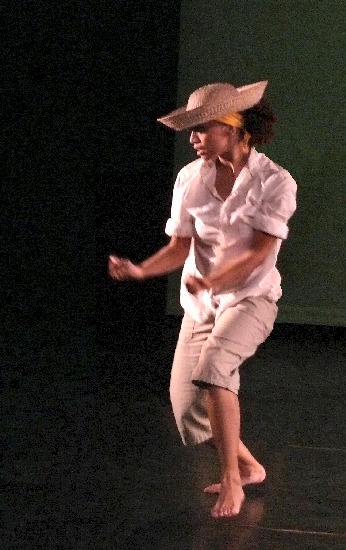
"Pisen la coca", as the third part of the piece, was dance theatre depicting the hard work on coca fields and deadly exhaustion of farm workers oppressed by the guards (Capataz). The performance closed with a piece of music, giving the audience time to assimilate their impressions and get ready to return to reality. The ovations did not end, enticing the musicians to play an encore. I was a bit concerned when Johnny announced that it would be El Condor Pasa, but the musicians safely circumnavigated bad stereotypes and received a second well-deserved ovation. It was a big success for Cynthia, her father and all the other artists involved. Isolde Matkey, whose Tristan Production managed Tanzherbst, made the right decision to select Bolivian Images both as the opening and closing performance of the festival.
Petr Karlovsky
